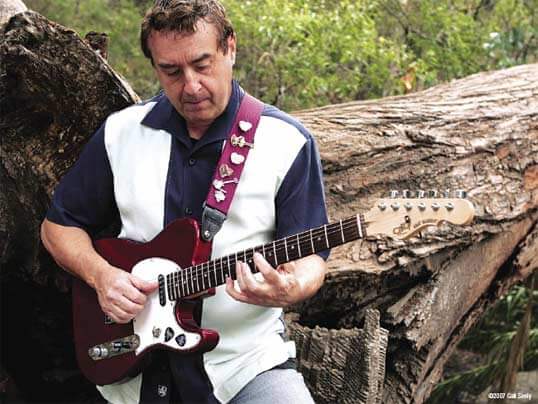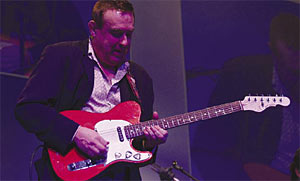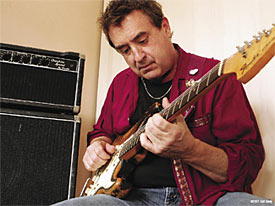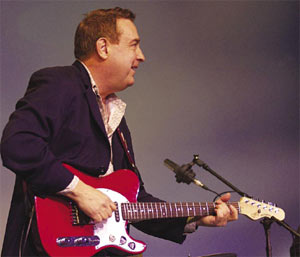
Quietly, outside of Los Angeles, Steve Trovato has been leaving blazing guitar everywhere he goes.
Currently, he is a full time instructor in the Studio Jazz Department at the University of Southern California. In addition, Steve has found the time to author over 20 instructional books for Warner Brothers and Hal Leonard, produce over 50 instructional videos for the likes of Yngwie Malmsteen and Paul Gilbert, and has even starred in five of them. His students have achieved major success and include Scott Henderson, Frank Gambale, Paul Gilbert and Norman Brown. He has performed with Chet Atkins, Albert Lee, Robben Ford, Jeff Berlin, Jerry Donahue and Scott Henderson, and contributes to five international music publications, including Guitar Player, Guitar One, Axe, Guitar Club, Guitar World and Chittar, as well as recording for too many studio and motion picture projects to list. We caught up with Steve as he completed his new release, Country Jazzmaster.

One of the things I have always wondered about is who or what influenced you to start playing guitar?
Well, I think you’ll hear this from a lot of guys; it was the Beatles. I think I was six years old, and I had been playing the piano. I did my piano recital and played “The Blue Danube Waltz.” Then I saw the Beatles on Ed Sullivan and I thought, “Wow, girls never screamed for me playing piano.” So that was it and I started playing the guitar. That was pretty much it, and I have never looked back.
Did you come across a single moment that it finally hit you? This is it, this is what I want to do the rest of my life?
I’ve never been asked that before; that’s a really good question. I would say that there were three pivotal moments: one of them was when I saw the Beatles, the second was when I heard Chet Atkins for the first time, and the third was when I was up on stage and I got a chance to play with Albert Lee — that was when I really knew I wanted to do guitar. For some reason those guys hit me hard — they played melodies — and I always loved the way I could track it even though it was guitar playing. It was really very sophisticated. When I heard Chet Atkins play, I could hear the melody. Even with all the notes that Albert Lee plays, I can still keep track of it– that’s what attracted me. I think since I’ve been playing, if I have anything, it’s the ability to play a melody.
 You’re originally from New Jersey. How did you end up on the West coast attending GIT (now the Musicians Institute)?
You’re originally from New Jersey. How did you end up on the West coast attending GIT (now the Musicians Institute)?
Like every guitar player on the East Coast, we were always hungry for information about the guitar. I used to get this magazine and I saw an ad for this place called GIT in California. I saw pictures of Larry Carlton, Tommy Tedesco and other people that I didn’t know, like Don Mock and Joe Diorio, and they were starting this school. They were sort of advertising it being for studio musicians, and that was what I wanted to be.
Now that you already have one CD under your belt, you’ve gone into the studio a second time with some outside input. How are you achieving your tones with the studio?
When I did my first album, I just took my rig into the studio with the thought that if it sounds good live, it will sound good in the studio. I’ve found that not to be true. I also realized that amps that are made specifically for recording don’t necessarily sound all that good in the studio. It really depends on the studio, the mics, and everything else. I brought every amp that I had down there — I even borrowed some amps. I ended up with five or six different amps and I had to just go through all of them to find out which one sounded the best in that studio — with that particular set up of room and microphones. I wound up actually using a boutique amp from a company in Virginia called Talos. I love those amps. It’s a 60-watt, one-twelve, and it just has two knobs on it, drive and gain.
“Well, I think you’ll hear this from a lot of guys; it was the Beatles. I think I was six years old, and I had been playing the piano. I did my piano recital and played ‘The Blue Danube Waltz.’ Then I saw the Beatles on Ed Sullivan and I thought, Wow, girls never screamed for me playing piano. So that was it and I started playing the guitar. That was pretty much it, and I have never looked back.”
What about guitars? Did you find that’s the same scenario to be true?
It’s something I suspected, but I never really had the chance to put it to the test. I usually use my G&L Legacy live, with the Kahler on it because it sounds great. You’re playing loud enough where if there’s a bass, drums and everything cranking you lose the nuances and the subtlety. But in the studio you retain those nuances and subtleties because everything is under a microscope. I found that using different guitars expresses that better.
If I want to play a sensitive, sort of Chet Atkins jazzy piece, the Legacy wouldn’t work because it sounds too thin, but with a loud phrase it will sound fine. For a quiet passage, I decided to use a Gibson — a Howard Roberts with two old humbuckers that I had. Of course, for the Straty-sounding things I used my red Legacy with a Kahler on it, which I absolutely love. For the rest of the stuff I used one of two Teles: a Fender solid body Telecaster and a G&L semi-hollow. None of them are stock. Seymour Duncan custom built the pickups for both of them.
What amps do you prefer for live performances?
I play rock, I use my Dumble. That, of course, is Alexander Dumble. It says “Built to win” and it really does, it’s just really something. I put a pedal in front of it to make sure it’s got enough overdrive. In the country bands I use a ’65 Pro Reverb, which Dumble rebuilt for me.
What do you use on the jazz side?
I use my Talos.
 Throughout your time as a guitar player, you’ve been labeled as the chameleon of guitar. Do have a huge arsenal of guitars at your disposal that you have hiding in the back room to take out whenever you need to?
Throughout your time as a guitar player, you’ve been labeled as the chameleon of guitar. Do have a huge arsenal of guitars at your disposal that you have hiding in the back room to take out whenever you need to?
For the live work I pretty much grab whatever is nearest to the front door on the way out. I was never really one to take ten guitars to a session because I figured that one guitar would sound just as good as 10 guitars, but when you really start to do this seriously, there are subtle differences between all guitars that may or may not sound better for the tracks. You really have to have an arsenal of quite a few to do the job right.
What would be an ideal arsenal?
I would have to say you have to have a solid body, Strat-type of guitar with single coil pickups, a single coil Tele-type, a Les Paul-type solid body with humbuckers, a thin semi-hollow body sound, like a 345, and a jazz box, then, of course, steel string acoustic and a nylon string.
You mentioned putting a pedal on the floor in front of one of the amps.
Live I use a Boss GT-6. I use it for time delay effects such as reverbs, delays and chorusing. It sounds great for that and it’s also great on the floor. For distortion I’ve been using the AC Booster and the RC Booster by Xotic Pedals.
The Xotic pedals are fairly new. Can you tell us some more?
Oh, I love them. Those are the kind of the boutique pedals that all the guys in town are using. Scott Henderson told me about them. Studio guys like Michael Thompson are using them. Basically, the RC Booster is a pre-amp boost that keeps it clear, but gives it a little oomph. The AC Booster is an overdrive — basically a really high-end Tube Screamer with a bass control on it. Everybody loves Tube Screamers, but it takes the bass away from it; this is a Tube Screamer that sounds a lot more transparent and smoother than normal. You can also roll the bass back in because it has bass and treble controls.
 You mentioned the Kahler Tremolo on one of your G&L’s. What do you like about it?
You mentioned the Kahler Tremolo on one of your G&L’s. What do you like about it?
The thing I love about the Kahler is its flush and mounted solidly on the guitar body, versus another one. I won’t mention any names, but the initials are Floyd Rose. It is not really mounted on the body of the guitar as solidly and or as flush as a Kahler. With a Kahler, the tone sounds pretty darned good. I really like that about the Kahler. Since you have that big plate to rest against the body, you get more natural wood resonance, it doesn’t sound thin and small. The other thing that I like is the adjustable string spacing. I don’t think other bridges can do that.
On the first CD, About Time, you cover a whole spectrum of guitar playing. You do a dedication to Danny Gatton, you’re hitting a little Django, you’ve got “Somewhere Over the Rainbow” from Harold Arlen, and then you even do Billy Joel’s “Root Beer Rag.” What can we expect hear on the new CD?
When I spoke with Steve Vai, he was saying the last CD was really good but I needed a little bit better recording quality. He said the problem with the first CD, as far as marketing, is that I don’t know where to market it stylistically; it’s all over the map. I came up with this concept in my mind called “Country Jazzmaster,” with Jazzmaster being one word, like the guitar. I kept that thread in my mind as I was recording this album, and all of the songs leaned into that concept. Everything that you’re going to hear is country-jazz. Western swing, country jazz — that sort of a thing.
There’s a thread of continuity running through the whole album that you will hear. I recorded everything from the old Jerry Reed tune, “Guitar Man,” to “Back Home Again in Indiana,” “That She Could Ever Be,” “Panhandle Rag” and my ultimate version of “Ghost Riders in the Sky.”
I still remember this vivdly: a NAMM show where you, Steve Vai and I were standing around talking, and Steve hailed you as, “One of the greatest Tele players of all time.” Will we hear evidence of this on the new CD?
That was very nice of him. But, yeah, that’s what I’m hoping for, and I think that it’s really extremely well played, if I can say so myself. We all worked really hard on it.
Trovato Gearbox: Here’s what Steve is plugging in, when it’s time to shine.
Country Gigs
Guitars
Amps
Effects
Rock/Blues Gigs
Guitars
Amps
Effects
Steve Trovato: It’s About Time and the new, Country Jazzmaster, are available at: cdbaby.com / myspace.com/stevetrovatomusic
Source: https://mercurymagnetics.com/pages/news/PremierGuitar/PremierG-07.htm